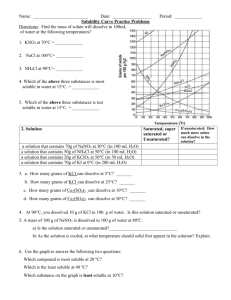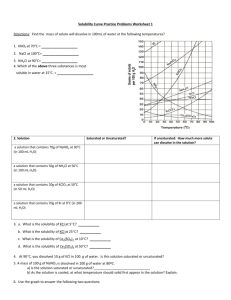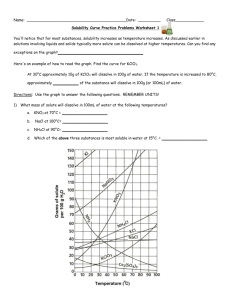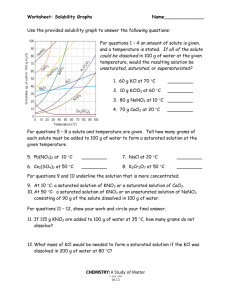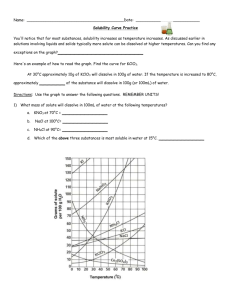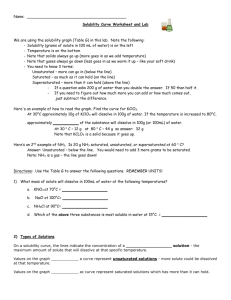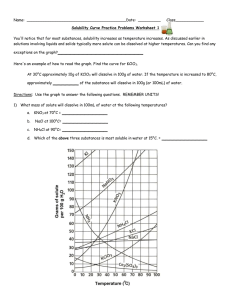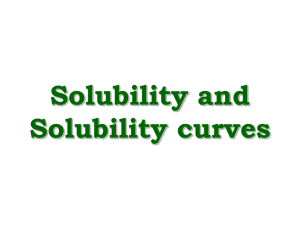Solubility-Curve
advertisement
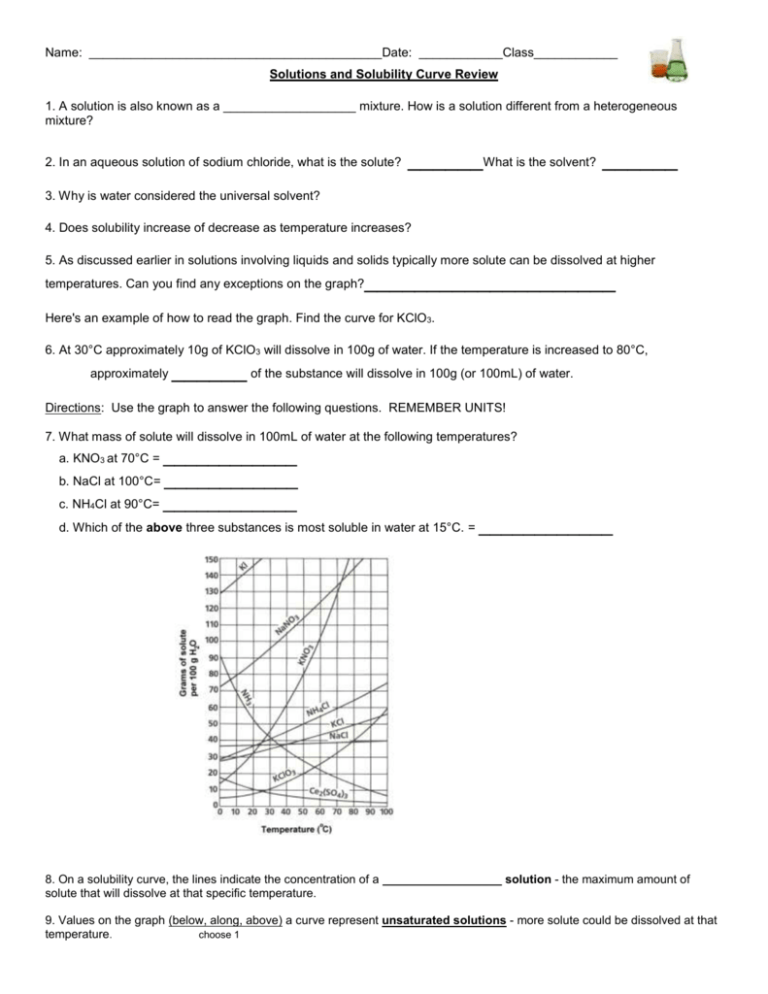
Name: __________________________________________Date: ____________Class____________ Solutions and Solubility Curve Review 1. A solution is also known as a ___________________ mixture. How is a solution different from a heterogeneous mixture? 2. In an aqueous solution of sodium chloride, what is the solute? ______What is the solvent? ______ 3. Why is water considered the universal solvent? 4. Does solubility increase of decrease as temperature increases? 5. As discussed earlier in solutions involving liquids and solids typically more solute can be dissolved at higher temperatures. Can you find any exceptions on the graph? ____________________ Here's an example of how to read the graph. Find the curve for KClO3. 6. At 30°C approximately 10g of KClO3 will dissolve in 100g of water. If the temperature is increased to 80°C, approximately ______ of the substance will dissolve in 100g (or 100mL) of water. Directions: Use the graph to answer the following questions. REMEMBER UNITS! 7. What mass of solute will dissolve in 100mL of water at the following temperatures? ____________ b. NaCl at 100°C= ____________ c. NH4Cl at 90°C= ____________ a. KNO3 at 70°C = d. Which of the above three substances is most soluble in water at 15°C. = ____________ 8. On a solubility curve, the lines indicate the concentration of a __________________ solution - the maximum amount of solute that will dissolve at that specific temperature. 9. Values on the graph (below, along, above) a curve represent unsaturated solutions - more solute could be dissolved at that temperature. choose 1 Types of Solutions - Use the Solubility Graphs on Page 1 10. Label the following solutions as saturated or unsaturated. If unsaturated, write how much more solute can be dissolved in the solution. Solution Saturated or Unsaturated? If unsaturated: How much more solute can dissolve in the solution? (a) a solution that contains 70g of NaNO3 at 30°C (in 100 mL H2O) (b) a solution that contains 50g of NH4Cl at 50°C (in 100 mL H2O) (c) a solution that contains 20g of KClO3 at 50°C (in 100 mL H2O) (d) a solution that contains 70g of KI at 0°C (in 100 mL H2O) 11. a. What is the solubility of KCl at 5C? b. What is the solubility of KCl at 25C? _____ _____ c. What is the solubility of Ce2(SO4)3 at 10C? d. What is the solubility of Ce2(SO4)3 at 50C? _______ _______ 12. a. At 90C, you dissolved 10 g of KCl in 100. g of water. Is this solution saturated or unsaturated? b. How do you know? 13. A mass of 100 g of NaNO3 is dissolved in 100 g of water at 80ºC. a) Is the solution saturated or unsaturated?______________________________ b) As the solution is cooled, at what temperature should solid first appear in the solution? Explain. 14. Use the graph to answer the following two questions: Which compound is most soluble at 20 ºC? ________ Which is the least soluble at 40 ºC? ________ 15. Which substance on the graph is least soluble at 10C? __________ 16. A mass of 80 g of KNO3 is dissolved in 100 g of water at 50 ºC. The solution is heated to 70ºC. How many more grams of potassium nitrate must be added to make the solution saturated? Explain your reasoning 17. What are 3 ways to increase the solubility of a solid substance in a solid? 19. How can the solubility of a gas in a liquid be increased? 20. What is the difference between polar and nonpolar substances? 20. Explain why not every substance dissolves in water. Use the words polar and nonpolar in your explanation. 21. Explain how both alcohols and soaps are able to dissolve both polar and nonpolar substances.
